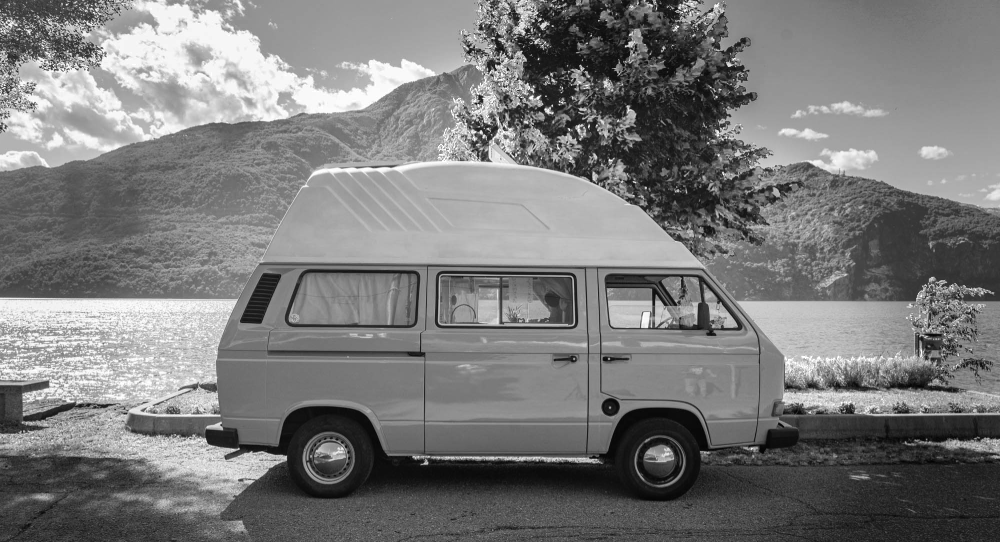Bruno, the Van That Sparked Controversy
BLOGGING AWAY
Bruno, the Van That Sparked Controversy
03.04.2025


A Dream on Four Wheels
I recently bought a vintage 1985 Volkswagen T3. For many, this van represents the icon of freedom—van life, adventure, a dream come true.
When I first saw this van, named Bruno, it sparked all kinds of positive emotions in me: Travel. Adventure. Warmth. Lightness. Fun. Play. Slow living. Care.
I had no clue that this same symbol could mean something entirely different to others.
An Unwelcome Arrival
I am based in a provincial town in northern Italy, known for not being the most open-minded place.
Bruno had been with me for less than 24 hours when I experienced something new: hostility toward a symbol and a lifestyle.
That night, I arrived back home at around 8 p.m. The garage where I had arranged to park the van was closed, so I left it on the street.
As I was adjusting Bruno into the parking space carefully, a neighbour rushed onto his balcony and started complaining to his wife.
"They cannot leave it here! They cannot!" he barked.
Bruno is small and nimble, fitting perfectly within a regular parking space. I checked—I wasn’t breaking any rules. My plan was simple: park for the night and move it before 9 a.m.
But the man kept grumbling to his wife, standing right outside on the balcony where I could hear, and see, everything.
"They cannot keep it here, these people!"
I reassured him, "Sir, don’t worry. I’ll move it first thing in the morning."
Offended—perhaps because he didn’t expect me to address him—he and his wife retreated inside. He added, "Better move it as soon as possible. What a piece of crap."
I was speechless.
An object I had instantly fallen in love with, was, to him, nothing but a "piece of crap"? I didn’t respond, and I walked away.
Cold Encounters at the Garage
The next morning, I took the van to the garage where, miraculously, I had found a spot. The owner looked at Bruno with a condescending expression and said, "These vehicles have zero value. They’re worth nothing."
Once again, I was stunned. Bruno, to me, was priceless—one of a kind.
He doubled down. "They’re worthless. I don’t even work on them."
I explained that yes, they’re expensive for what they are, but they have a dedicated market. While rare in Italy, they’re beloved elsewhere.
He shrugged. "Yeah, you don’t see many here. In Germany, though, they’re popular."
He showed me the only available space in the garage. The parking spot was… underwhelming. A makeshift shelter with metal poles sticking out, an uneven, messy floor. It wasn’t what I had envisioned for Bruno, but I had no other choice.
Then his wife arrived and, much like her husband, wasted no time in telling me that Bruno was nothing special: "We have campers here worth much more," she said, unimpressed.
Why So Much Disdain for Bruno?
And that’s when it hit me. I had never experienced this kind of treatment before.
Yes, I had faced some racism while living in the UK as a foreigner. Yes, I had encountered discrimination as a woman. But overall, I know I am privileged—I come from the "right" part of the world.
For years, I drove an old, second-hand Polo that I liked—nobody cared. Then I upgraded to a Mini Cabriolet, a car some people love, but still, no one reacted to it.
But Bruno?
Bruno is different.
It's so visible, so unapologetically bright yellow, so iconic. It provokes emotions in people—for some, like me, it radiates joy, freedom, and nostalgia. For others, it stirs something entirely different.
A Mirror on Wheels
What struck me from this experience is how differently people react to the very same object. This contrast isn’t really about the van—It’s about the relationship that we have, within us, with what the object symbolizes.
Whether something that we accept, or reject. It’s a personal inner tale.
In this way, Bruno rolls through people’s projections. He reflects their values, fears, memories, and prejudices. He stirs whatever lies beneath the surface.
Symbols like this van are never neutral. They carry cultural weight, personal associations, and untold stories. And depending on who’s looking, they can mean joy, rebellion, chaos, or belonging.
Bruno didn’t just park on the street—he parked in someone’s worldview. And their reaction revealed more about them than about it.
Perhaps that’s the real journey: not just moving through places, but witnessing how each place—and each person—reveals itself through what it sees in us.
My office
Anywhere in the world
Contact
hello@valeriafontana.com
